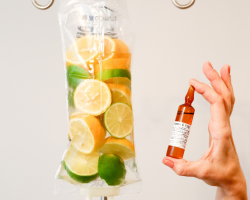I.V. fluid treatment expects a significant part in the organization of hospitalized patients. While the right use of i.v. fluids can be lifesaving, progressing composing shows that fluid treatment isn’t without bets. Without a doubt, the use of explicit sorts and volumes of fluid can fabricate the bet of harm, and, surprisingly, passing, in a couple of patient social occasions. Data from another audit show us that the improper usage of fluids could occur in up to 20% of patients seeking fluid treatment. The specialists of the twelfth Acute Dialysis Quality Initiative (ADQI) Conference attempted to secure a settlement on the usage of iv drip near me entirely settled to make bearing for their usage.

we study an actually proposed model for fluid treatment in outrageous sepsis and propose a framework by which it might be embraced for use, generally speaking, where the fluid organization is required. Considering the part sway relationship and side effects of fluids, fluid treatment should be regarded like other prescription treatments with unequivocal signs and handcrafted recommendations for the sort and piece of fluid. By focusing on the need to individualize fluid treatment, we want to decrease the bet on our patients and work on their outcomes.
Methodologies
For the specific procedure used in this ADQI meeting, we imply perusers to the underlying article going with this paper in the new worry of the Journal.12 Before the start of the social event, the working get-together discussed the proposed requests by electronic mail and thus perceived and shared the relevant composition on which to base discussion and inescapable arrangement. A formal exact review was not coordinated.
Results
The use of fluid recovery therapy isn’t dependent upon a specific region of the patient in or past the clinical facility, however, rather on the sign for fluid treatment for the event, a patient with septic shock will be controlled by a practically identical fluid restoration framework in the emergency division and the crisis unit (Also, different endpoints and methodologies for achieving those endpoints have been portrayed, from time to time depicting differentiating medicines using a comparable phrasing.
Supportive therapy study
- The workgroup esteemed that the answer for the requests introduced would depend upon the clinical setting, the environment, and the endpoints that are used in individual assessment studies. This was actually displayed in the Fluid Expansion as Supportive Therapy study, where adolescents on admission to a crisis center in Africa with outrageous infection were randomized to get no fluid boluses (control, standard of care), or to get fluid boluses with either saline (NaCl 0.9%) or albumin.
- 14 At 1 h, more patients who got fluid boluses showed reversal of shock differentiated and patients who didn’t get a fluid bolus. In any case, when 48 h mortality was evaluated, patients who got fluid boluses had higher mortality differentiated and control patients (relative bet 1.45, 95% sureness range 1.13-1.86, P=0.003).15 This fundamental was driven in resource sad crisis facilities with no induction to ventilation to improve the organization of sepsis and tantamount conditions here.
How the Fluid Rate Is Controlled :
A machine called implantation siphon control how much liquid goes into your youngster’s vein every hour. The IV tubing is strung through the siphon. The siphon is customized to the speed (stream rate) expected to give your kid the perfect proportion of liquid. Assuming the stream rate changes, the machine detects it and sounds an alert. This caution makes the attendant aware of right the stream rate.
